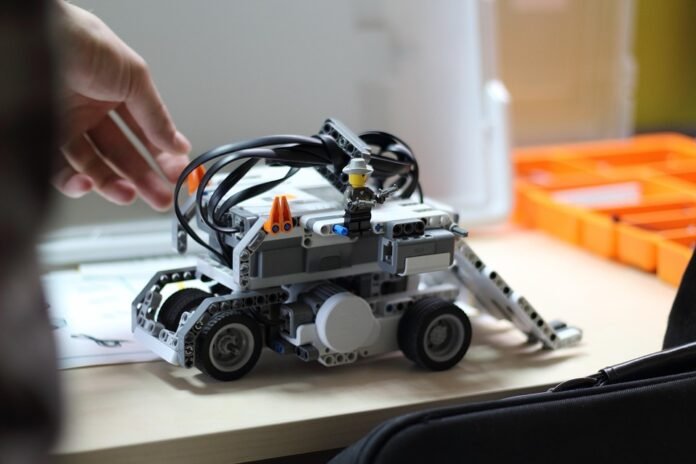Of course! Here is an article on the topic.
From Farm to Table: The Agricultural Robots Feeding the World
The traditional image of farming often evokes rolling hills, a farmer on a tractor, and hands deep in the soil. While that heritage remains the heart of agriculture, a quiet revolution is taking place in fields and greenhouses across the globe. This revolution isn’t driven by a new type of seed or fertilizer, but by steel, sensors, and artificial intelligence. Agricultural robots, or “agbots,” are transforming every step of the food production process, tackling some of humanity’s most pressing challenges.
As the global population surges towards a projected 10 billion by 2050, the demand for food is skyrocketing. Yet, agriculture faces immense pressure: a shrinking and aging workforce, the unpredictable impacts of climate change, and an urgent need for more sustainable practices. Enter the new farmhands—tireless, precise, and data-driven machines designed to help farmers feed the world more efficiently and sustainably than ever before.
The Field of the Future: Precision from Seed to Soil
The work of an agbot begins before a single seed is even planted. Autonomous tractors, guided by hyper-accurate GPS, can plow, till, and prepare fields with sub-inch precision. This eliminates overlaps, saving fuel and reducing soil compaction.
But the real intelligence lies in the details. Drones and small, roving robots scan the terrain, collecting data on soil moisture, nutrient levels, and topography. This information creates a detailed map that allows for precision planting, where robotic seeders place each seed at the optimal depth and spacing. This isn’t just about straight rows; it’s about giving every single plant its best chance to thrive, maximizing yield from the very start.
The Vigilant Guardians: Weeding and Pest Control Without Chemicals
One of the most labor-intensive and environmentally taxing parts of farming is weed control. Traditionally, this meant back-breaking manual labor or the widespread application of chemical herbicides. Today, a new generation of robots is offering a smarter, greener solution.
Armed with high-resolution cameras and machine learning algorithms, these robots patrol the fields, distinguishing crops from weeds with incredible accuracy. Instead of spraying an entire field, they employ pinpoint methods. Some, like the robots from Carbon Robotics, use high-powered lasers to zap weeds instantly, leaving the crops untouched. Others use micro-doses of herbicide applied directly to the weed, reducing overall chemical use by up to 90%. This not only protects the environment and improves soil health but also opens the door for more farmers to adopt organic practices.
The Gentle Harvest: Picking the Fruits of Labor
Harvesting delicate produce like strawberries, apples, and tomatoes has long been considered a task too complex for automation. It requires a gentle touch, a keen eye for ripeness, and the ability to navigate complex foliage. This is where the convergence of AI-powered vision systems and soft-robotics is making its mark.
Modern harvesting robots feature multi-jointed arms with soft, pliable grippers that mimic the dexterity of the human hand. Their cameras can identify and assess the color, size, and ripeness of each fruit in milliseconds. They can work 24/7, day or night, in any weather, addressing the critical labor shortages that often leave ripe produce rotting in the fields. By ensuring more of the crop is harvested at its peak, these robots are directly fighting food waste.
Beyond the Field: Sorting, Packing, and Monitoring
The journey from farm to table doesn’t end at the harvest. In packing houses, automated systems are already at work. AI-driven optical sorters scan and grade produce faster and more consistently than the human eye, sorting fruits and vegetables by size, color, and quality. Robotic arms then gently pack them into boxes, preparing them for shipment.
Even livestock farming is being transformed. Drones monitor the health and location of cattle in vast pastures, while automated feeding systems ensure each animal receives a precise, customized diet. This constant monitoring improves animal welfare and allows farmers to intervene early at the first sign of illness.
More Than Machines: A Partnership for the Future
The rise of agricultural robots is not about replacing farmers; it’s about empowering them. These technologies free farmers from the most repetitive and physically demanding tasks, allowing them to focus on the strategic side of farming—analyzing data, managing their robotic fleet, and making smarter decisions for their land.
Of course, challenges remain. The high upfront cost of this technology can be a barrier for smaller farms, and a new set of skills is required to operate and maintain these sophisticated machines. However, as the technology becomes more accessible and its benefits more apparent, the agbot revolution is set to accelerate.
The farmer of the future may spend less time in the driver’s seat of a tractor and more time managing a dashboard of data. But their connection to the land and their mission to feed the world will be stronger than ever, supported by a tireless team of robotic partners working from farm to table.

